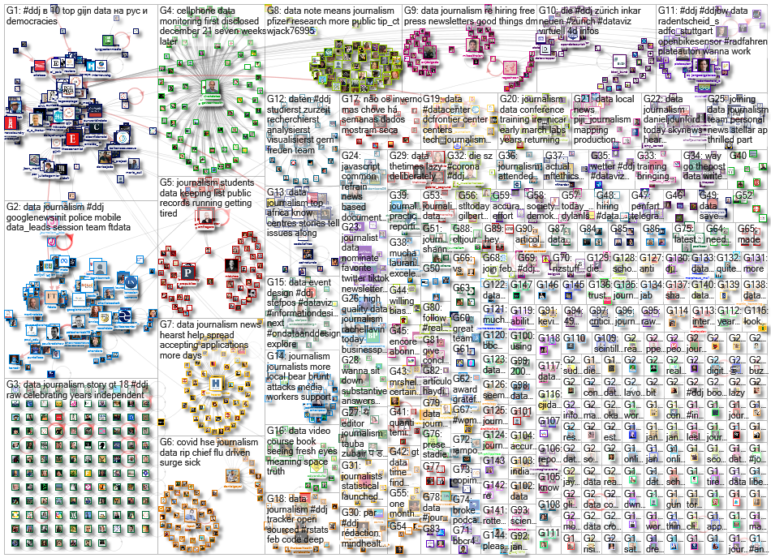
Reuters produced a data visualization of possible scenarios of EV adoption in the US. Image: Screenshot
The COVID-19 pandemic has definitely impacted our collective global citizenry. Zeit Online documented almost daily occurrences of violence in disputes over protective measures in Germany, and VOCÊ S/A reports that Brazilians are resigning from jobs in droves in search of better pay and work conditions, triggered by the pandemic. Our weekly NodeXL curation of the most popular data journalism stories on Twitter also features Reuters’ look at America’s transition from gas-powered to electric vehicles, FiveThirtyEight’s analysis on the legacy of discriminatory housing practices, and The Economist’s piece on judging bias in Olympic ski jumping.
Long Journey to Electric Car Adoption
How feasible is it to get drivers to switch from gas-powered to electric vehicles in the United States in order to achieve carbon-neutral status by 2050? Reuters examined the probability of this transition. Its team visualized several scenarios with different policies to help speed up the adoption of electric cars. The success, or failure, of the shift to EVs road is influenced by many factors, including purchase prices and incentives, limited driving range, and lack of sufficient charging infrastucture. Bonus: Reuters released a graphics kit, customizable for your own graphics projects.
Excellent graphics and story about the hurdles to #EV transition: "Lower-income areas in largely Black and Hispanic neighborhoods in California continue to be significantly less likely to have access to public chargers" https://t.co/ULZQemvg7t @fcage @reutersgraphics
— Rocky Kistner (@therockyfiles) February 8, 2022
The Lasting Legacy of Redlining
For decades in the United States, predominantly Black neighborhoods were racially discriminated against and marked as high risk for mortgage loans by the nation’s home lenders — a practice known as redlining. To examine the legacy of redlining, FiveThirtyEight analyzed data by the University of Richmond’s Mapping Inequality project and the 2020 census. It discovered that formerly redlined zones are still disproportionately Black, Latino, or Asian today, although the practice was officially outlawed 50 years ago. Data visualization journalist Ryan Best, who co-authored the story, explained the process of creating maps for this piece in a tweet thread. Find the data on GitHub. Related throwback: In 2020, we featured The New York Times’ article on how former redlined cities are suffering from higher temperatures compared to wealthier, whiter parts of the same city.
We analyzed 138 formerly redlined cities and found that most are still segregated decades after redlining was banned –– evidence of how redlining cemented systemic racism across the country. 🧵
.@ryanabest + me for @FiveThirtyEight: https://t.co/4jEYMyzp3d
— Elena Mejía (@elena___mejia) February 9, 2022
Olympic Judges’ Scoring Bias
The sport of ski jumping is not only scored based on an individual’s athletic ability of leaping the furthest, but on style as well. This allows room for judging subjectivity to affect the scores. The Economist visualized the findings of a paper by scholars Alex Krumer, Felix Otto, and Tim Pawlowski, which examined 15,355 ski jumps in men’s competitions held from 2010 to 2017. The researchers found that the judges’ nationalist bias was modest, but widespread, and interestingly correlated with that country’s level of corruption, as measured by Transparency International’s Corruption Perceptions Index. The data team augmented the research with additional data from two Winter Olympics, and found that judges’ bias at the Games increased, possibly due to patriotism running especially high. Also worth a look: Bloomberg’s beautiful graphics tracking the 2022 Winter Olympics medal count.
The academics found that Russian judges exhibited the largest bias; while Norwegian and Finnish judges exhibited little bias. What is more, there was strong correlation between average country bias and perceived corruption. (3/5) pic.twitter.com/OhqcNO5pJK
— James Fransham (@JamesFransham) February 11, 2022
The Pandemic of Violence
What happens when you approach an unmasked COVID-19 denier and ask the person to wear a mask? If you’re lucky, you walk away unharmed. According to research by Germany’s Zeit Online, based on publicly accessible data such as police reports and media reports, there were more than 300 violent attacks in the country in 2021 related to disputes over pandemic protective measures. These incidents happened on buses and trains, at the bakery, in the supermarket, and at demonstrations. The data journalists plotted these cases along a timeline, showing that they occur almost every day, and resulted in at least one murder.
Alltägliche, physische Gewalt durch Maskenverweigerer und Coronaleugner: Wir sind auf mehr als 300 Fälle im Jahr 2021 gestoßen. Und mit Sicherheit gibt es eine viel höhere Dunkelziffer. #PandemieDerGewalt https://t.co/qMSvhlAgoj
— Christian Bangel (@christianbangel) February 10, 2022
A Peek at COVID Inside Amazon Warehouses
Data about COVID-19 cases among Amazon warehouse workers in the United States has not been forthcoming throughout the pandemic. By analyzing screenshots of pandemic alerts sent by the online delivery giant to selected personnel, data-driven investigative news site The Markup tallied up the number of coronavirus cases inside two Amazon warehouses. The data gives a glimpse of a surge in cases even as the company was easing up on pandemic safety protocols.
Amazon won't disclose COVID case counts in its warehouses, so @tenuous and I dug up our own data.
With help from workers and a new law in CA, we found that during Omicron:
1 Rialto, CA, warehouse had 1,038 cases
1 Stockton, CA, warehouse had 832 caseshttps://t.co/izrfEfvhOu— Dara Kerr (@darakerr) February 10, 2022
The Great Resignation in Brazil
As the pandemic endured through 2021, forcing employees to pivot and juggle childcare and work from home, a record number of US workers quit their jobs. This trend was dubbed the “Great Resignation.” Brazilian magazine VOCÊ S/A reports that Brazil is experiencing a similar phenomenon: every month, almost 500,000 workers are resigning from their jobs — twice the number recorded in the years prior to the pandemic.
Análise da Lagom Data na @vocesa deste mês: você sabia que, em 2021, cada vez mais trabalhadores brasileiros pediram demissão? Os motivos vão de chefe negacionista da pandemia à vontade/necessidade de trabalhar de casa por causa da família. https://t.co/1FZm9Kva7f
— Lagom Data (@DataLagom) February 11, 2022
Air Pollution in Spain
How contaminated is the air around nurseries and primary schools in Spain’s cities? EL PAÍS discovered that more than 190,000 children under the age of 12 attend a school in Madrid or Barcelona where levels of nitrogen dioxide exceed the legal limit established by the European Commission in 2010. Readers can explore the average levels of pollution around these schools using the interactive map created by the Spanish language daily.
¿Qué aire respira tu hijo cuando va al colegio en Madrid o Barcelona? En @elpais_eco hemos hecho un mapa para que puedas buscar la contaminación que sufren los niños mientras están en la escuela. A las 9, casi todos soportan más polución de la permitidahttps://t.co/0AQ36PMeyt pic.twitter.com/quW7aOcXMu
— Miguel Ángel Medina (@locodelpelorojo) February 15, 2022
Droughts in Portugal
Droughts are no longer a rare phenomenon in Portugal; much of the country has experienced drought since 2000. But this ominous trend is only expected to worsen, exacerbated by climate change. Portuguese newspaper Publico examined which regions suffer the most from droughts from 2000 to present day and visualized the data using heat maps.
A severe #drought is ongoing in #Portugal. It's winter, but it hasn't rained seriously since October. The entire Portuguese mainland is in drought and it will worsen in the future — droughts will become +intense, +frequent, and +prolonged. #ClimateCrisishttps://t.co/QX6OgK311K
— Rita Sousa-Silva (@RitaSSilva) February 11, 2022
Russian Military Movements Database
As Russia continues to gather military forces along its border with Ukraine, there has been a concerted effort to map, document, and verify crowdsourced videos, photos, and imagery that offer information about the Russian military’s movements. This Russia-Ukraine Monitor Map, created by the Centre For Information Resilience, which now has more than 250 geolocated entries of footage mapped, is a result of those efforts.
A lot of footage is being posted online of Russian military movements along the Ukrainian border. We’re working with the #OSINT community to document, verify & map this information. You can find our map of verified movements here: https://t.co/2uqsSML5Qe pic.twitter.com/ToGku2xX8G
— Centre for Information Resilience (@Cen4infoRes) February 9, 2022
The Data Journalism Podcast
The latest episode of The Data Journalism Podcast by Alberto Cairo and Simon Rogers has dropped. In it, they speak to Ben Welsh, data journalist at The Los Angeles Times, and MaryJo Webster, data editor at the Minneapolis Star Tribune, about their work, favorite tools, and guilty data hacks. Missed the earlier episodes? Catch up on all the past interviews, featuring The Pudding’s Matt Daniels and Caitlyn Ralph, ProPublica’s Scott Klein, The Associated Press’ Angeliki Kastanis, and more.
Listen to me and Ben Welsh (@palewire) talk data journalism on the Data Journalism podcast, with hosts @AlbertoCairo and @smfrogers https://t.co/6ZDlgW26bo
— MaryJo Webster (@MaryJoWebster) February 9, 2022
Thanks again to Marc Smith and Harald Meier of Connected Action for gathering the links and graphing them. The Top Ten #ddj list is curated weekly.
 Eunice Au is GIJN’s program manager. Previously, she was a Malaysia correspondent for Singapore’s The Straits Times, and a journalist at the New Straits Times. She has also written for The Sun, Malaysian Today, and Madam Chair.
Eunice Au is GIJN’s program manager. Previously, she was a Malaysia correspondent for Singapore’s The Straits Times, and a journalist at the New Straits Times. She has also written for The Sun, Malaysian Today, and Madam Chair.

